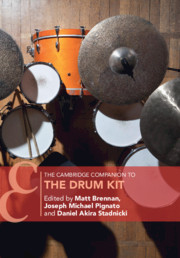Figures
2.1Original Memphis Five, 1922: drummer Jack Roth on a snare drum only. Originally published in Record Research.
2.2Top: An unknown band broadcasting from the Detroit News Auditorium, 1922. Bottom: Ted Lewis and his band broadcasting from the Union Trust Co.’s radio station in Cleveland, Ohio, at seven o’clock p.m. on Tuesday, 24 October 1922.
3.1Slingerland 1928 catalog, page 31
3.2Bennie Moten Radio Orchestra, 1922 (Willie Hall, drums; from the ‘Goin’ to Kansas City’ Collection, courtesy of Herman Walder and the Kansas City Museum)
3.3Big Jay McNeely, Olympic Auditorium, Los Angeles, 1951 (used with permission of © Bob Willoughby, mptvimages.com)
6.1Recommended Ti.re-Ti.ke-Dha setup with bongos, conga and purpleheart. Image created by the author
6.2Foot techniques: closed HH with foot (𝆯); open HH with foot (𝆮); HH struck with stick (𝆜); repeating bass drum pulse, mm. 1 and 2. James Dillon: Ti.re-Ti.ke-Dha. Edition Peters No.7242 © 1982 by Peters Edition Limited, London
8.1Jay Bellerose performing at The York in Los Angeles with Molly Miller (guitar) and Jennifer Condos (bass) in September 2019. Image credit: Lawrence Buccat (screen shot of YouTube video, used with permission)
10.1The arrangement of the drum kit course within the two-performance module structure
10.2The PAD notation clef and legend
10.3The hand-drawn layout of an SPD-20 used by a student to learn a hybrid performance
10.4How MIDI signals generated by a software score could be processed to activate the correct samples in a software sampler

